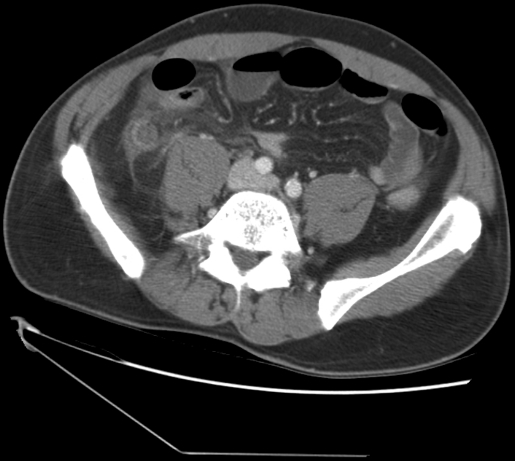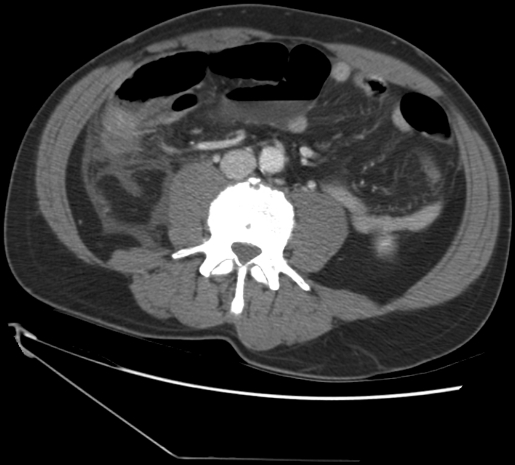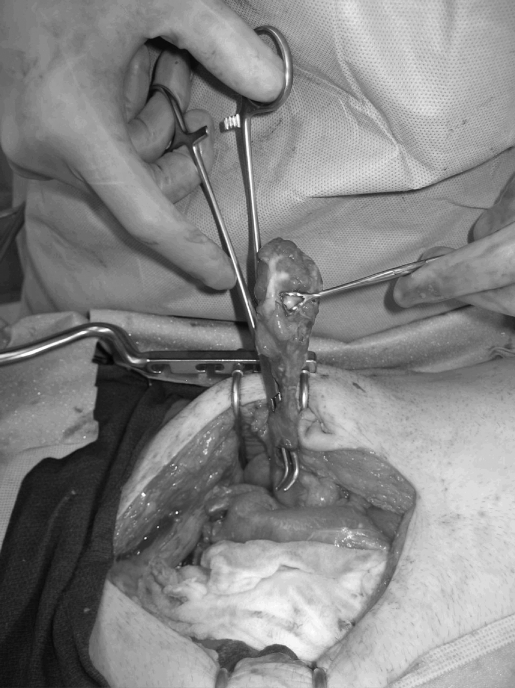Abstract
Background:
Acute appendicitis is a rare complication of colonoscopy that has been reported only 12 times in the English-language literature and is usually associated with obstruction of the appendiceal lumen with fecal matter during colonoscopy. None of the previous reports have described findings of perforation of the appendix within 24 hours of colonoscopy.
Methods:
We present the case report of a patient who underwent urgent laparotomy within 16 hours of colonos-copy for findings of free intraabdominal air and peritonitis from acute perforated appendicitis.
Results:
Laparoscopy confirmed 2 perforations of the appendix and diffuse peritonitis. Laparotomy was necessary to perform appendectomy, exclude a right colonic injury, and control intraabdominal sepsis.
Conclusion:
In patients with abdominal pain who have had a recent colonoscopy, a high index of suspicion is necessary for accurate diagnosis of perforated appendicitis. Perforation can occur hours after colonoscopy even when a biopsy is not performed.
Keywords: Perforated appendicitis, Colonoscopy
INTRODUCTION
Appendicitis after colonoscopy is a rare condition that has been reported only 12 times previously in the English-language literature. We searched PubMed for the years 1985 through 2007, using the search terms “acute appendicitis, perforation, and colonoscopy.” The current case presents the unique findings of perforation of the appendix at 2 distinct sites immediately after colonoscopy, suggesting a new mechanism to the development of post-colonoscopy appendicitis.
CASE REPORT
A 55-year-old otherwise healthy man underwent screening colonoscopy without a biopsy at 8:00 am. He was observed for 3 hours and discharged home at noon. Over the next 2 hours, marked abdominal pain developed acutely, which led him to be brought in by ambulance to the emergency department 4 hours later. An initial upright abdominal radiograph revealed multiple dilated loops of small bowel measuring up to 3.4cm in diameter, without intraperitoneal free air. A computed tomography (CT) scan was promptly obtained to investigate other causes of his abdominal pain. This revealed a thickened appendix measuring 15 mm with an irregular wall (Figure 1) and surrounding fluid and fat stranding (Figure 2). Associated free fluid in the pelvis was suggestive of perforated appendicitis. Given the presence of acute peritonitis on physical examination, the patient was brought urgently to the operating room with a suspicion of perforated viscus.
Figure 1.
Computed tomographic scan demonstrating an enlarged appendix measuring 15mm and mild dilation of the adjacent small bowel.
Figure 2.
Computed tomographic scan demonstrating adjacent fluid and fat stranding, without evidence of free intraperitoneal air.
During the initial attempt at diagnostic laparoscopy, the patient had marked right lower-quadrant inflammation that raised the suspicion of right colonic injury. This required conversion of the procedure to exploratory laparotomy. The patient was found to have 2 perforations of a necrotic appendix (Figure 3) and diffuse peritoneal contamination, requiring open appendectomy, irrigation of intraabdominal infection, and drain placement. The cecum and right colon were inspected and found to be uninjured.
Figure 3.
Photograph taken during the operation revealing 2 perforations of a necrotic appendix, demonstrated with a right-angle clamp.
The patient recovered uneventfully. Pathological examination revealed acute gangrenous appendicitis with 2 sites of perforation. One at the body of the appendix measured 0.8×1 cm; the other near the tip measured 1×1 cm.
No fecalith was found during the operation or in the pathologic specimen.
DISCUSSION
Perforated appendicitis occurring shortly after colonos-copy has not been reported previously. Our search of the English-language literature found only 12 reported cases of acute appendicitis after colonoscopy. Each reported acute nonperforated appendicitis, and none described the perforation of the appendix within hours after colonos-copy.1–12
The mechanisms by which colonoscopy might induce acute appendicitis are unknown, but other studies have postulated the following (1): pre-existing subclinical disease of the appendix,7,11 (2) barotrauma resulting from overinsufflation,7 (3) introduction of a fecalith or impaction of stool into the appendix, leading to obstruction or inflammation,1,7,10 and (4) direct intubation of the appendiceal lumen or local edema from trauma induced by the endoscope.1,2,7,12
Our patient had no symptoms of appendicitis before colonoscopy, and no findings during the procedure were suggestive of acute appendicitis. Diffuse peritonitis with pelvic fluid developed rapidly within 16 hours of the procedure; this time course suggests that the perforation may have been related to excess pressure from the endo-scope at the appendiceal lumen, and possible excess inflation.
The fact that there were 2 sites of perforation— one at the body of the appendix and one near the tip may be explained several ways. Possible entry of the colonoscope into the appendiceal lumen appears unlikely given the size of the colonoscope. It would also be very unlikely for the colonoscope to have perforated the appendix proximally, and then reentered the tip distally. Another explanation is that there was a fistula of the appendix to itself, which was disrupted by insufflation during the colonos-copy. This barotrauma may have led to immediate perfo-ration of the appendix, in the absence of a fecalith.
Diagnostic colonoscopy is a relatively low-risk procedure.13,14 Appendicitis is a rare but important complication of colonoscopy, and, as this case shows, can occur hours after the procedure. We therefore think physicians who perform colonoscopies should consider a perforated appendix in the differential diagnosis of postprocedure abdominal pain, in addition to possible occult colonic injury. Heightened awareness of this condition may lead to prompt recognition and treatment. A CT scan and physical examination should be used to confirm the diagnosis, and laparotomy may be required if marked intraabdominal inflammation is present.
Acknowledgments
The authors thank Pamela Derish in the UCSF Department of Surgery for editorial assistance.
References:
- 1.Izzedine H, Thauvin H, Maisel A, Bourry E, Deschamps A. Postcolonoscopy appendicitis: case report and review of the literature. Am J Gastroenterol. 2005;100:2815–2817 [DOI] [PubMed] [Google Scholar]
- 2.Lipton S, Estrin J. Postcolonoscopy appendicitis: a case report. J Clin Gastroenterol. 1999;28:255–256 [DOI] [PubMed] [Google Scholar]
- 3.Houghton A, Aston N. Appendicitis complicating colonos-copy. Gastrointest Endosc. 1988;34:489. [DOI] [PubMed] [Google Scholar]
- 4.Brandt E, Naess A. Acute appendicitis following endoscopic polypectomy. Endoscopy 1989;21:44. [DOI] [PubMed] [Google Scholar]
- 5.Hirata K, Noguchi J, Yoshikawa I, et al. Acute appendicitis immediately after colonoscopy. Am J Gastroenterol. 1996;91:2239–2240 [PubMed] [Google Scholar]
- 6.Takagi Y, Abe T. Appendicitis following endoscopic polypectomy. Endoscopy. 2000;32:S49. [PubMed] [Google Scholar]
- 7.Vender R, Larson J, Garcia J, et al. Appendicitis as a complication of colonoscopy. Gastrointest Endosc. 1995;41:514–516 [DOI] [PubMed] [Google Scholar]
- 8.Rosen MJ, Sands BE. Acute appendicitis following colonos-copy. J Clin Gastroenterol. 2005;39:78. [PubMed] [Google Scholar]
- 9.Srivastava V, Pink J, Swarnkar K, et al. Colonoscopically induced appendicitis. Colorectal Dis. 2004;6:24–25 [DOI] [PubMed] [Google Scholar]
- 10.Doohen RR, Aanning HL. Appendiceal colic: a rare complication of colonoscopy. S D J Med. 2002;55:526–527 [PubMed] [Google Scholar]
- 11.Petro M, Minocha A. Asymptomatic early acute appendicitis initiated and diagnosed during colonoscopy: a case report. World J Gastroenterol. 2005;11:5398–5400 [DOI] [PMC free article] [PubMed] [Google Scholar]
- 12.Volchok J, Cohn M. Rare complications following colonos-copy: case reports of splenic rupture and appendicitis. JSLS. 2006;10:114–116 [PMC free article] [PubMed] [Google Scholar]
- 13.Waye J, Lewis B, Vessayan S. Colonoscopy: a prospective report of complications. J Clin Gastroenterol. 1992;15:347–351 [PubMed] [Google Scholar]
- 14.Macrae F, Tan K, Williams C. Towards safer colonoscopy: a report on the complications of 5000 diagnostic or therapeutic colonoscopies. Gut. 1983;24:376–383 [DOI] [PMC free article] [PubMed] [Google Scholar]





